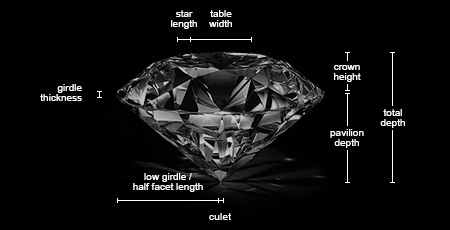Diamond Cut
A diamond's 'brilliance' can be significantly maximised or weakened according to the way it is cut. Its proportion, symmetry and polish strongly influence how the diamond reflects light, which is what gives it its flashy sparkle.
A diamond's cut controls its:
Brilliance
The amount of light that a diamond reflects equals its brilliance. As light hits the surface of the diamond, some light will be reflected off its angles and ridges, while other light will enter the diamond.
Scintillation
When a diamond is tilted from side to side, the sparkles of light that occur are called scintillation, which happens when the light that enters the diamond reflects and rebounds within its internal walls.
Fire
Once light is reflected off the inside walls of the diamond towards its centre, this light will exit through the top of the diamond. During this process, a colour spectrum can be seen as the light that travels up the centre of the diamond is slightly bent. This refers to the diamond's fire.
A well-cut diamond will produce a high light return, with excellent brilliance, scintillation and fire qualities. A poorly cut diamond will inhibit light from entering the diamond or leak out light through its sides and bottom. As a result, the diamond will appear dark and dull, no matter how clear or pure its colour and clarity are.
Diamond Cut Grades
| Ideal/Excellent | These almost perfect cuts are very rare, and reflect almost all of the light that enters the diamond with optimum brilliance, scintillation and fire. |
|---|---|
| Very Good | These extremely valuable diamonds reflect an overwhelming majority of the light that enters them with very good light performance. |
| Good | These diamonds reflect most of the light that enters them to a good degree of performance. They are valued significantly lower than diamonds with Very Good cuts. |
| Fair | With less brilliance and only a fair level of light performance, these diamond cuts are still considered of desirable quality. |
| Poor | These diamonds are usually cut too deep or shallow, resulting in a significant loss of light and a poor overall light performance. |
Diamond structure
These key parts of a diamond's anatomy are vulnerable to how its cut performs:

| Table | The largest part of a polished diamond on the top surface. |
|---|---|
| Culet | The small flat area at the bottom tip of a polished diamond. |
| Depth | A polished diamond's total length, measured from the culet to the table. |
| Diameter | A polished diamond's width from one side of the girdle to the other. |
| Girdle | A polished diamond's widest edge, where the crown ends and meets the pavilion. |
| Crown | The top part of a polished diamond, measured from the table surface to the girdle. |
| Pavilion | The bottom part of a polished diamond, from the girdle to the culet point. |
How will a diamond is cut affects its proportion, symmetry and polish:
Proportion
Dark spots will be created within a diamond if the angle of its pavilion is too deep or shallow, causing light to escape out. Depth and table percentages are also important to a good-quality cut. Shallow diamonds have lower depth percentages than deeper diamonds. A round diamond should aim for a depth percentage of between 50% and 62.5%. Diamonds with large tables have higher table percentages than diamonds with small tables. A round diamond should aim for a table percentage of between 53% and 59%.
Symmetry
Discrepancies in a diamond's symmetry will inhibit its brilliance, scintillation and fire elements, creating visual imbalances and distortions. Round diamonds should be completely round and symmetrical, with a centred culet.
Polish
Polishing every facet of the diamond is the last step after cutting. An excellent polish will leave no visible scratches or markings. A poor polish will scratch the diamond or leave streaks.
















